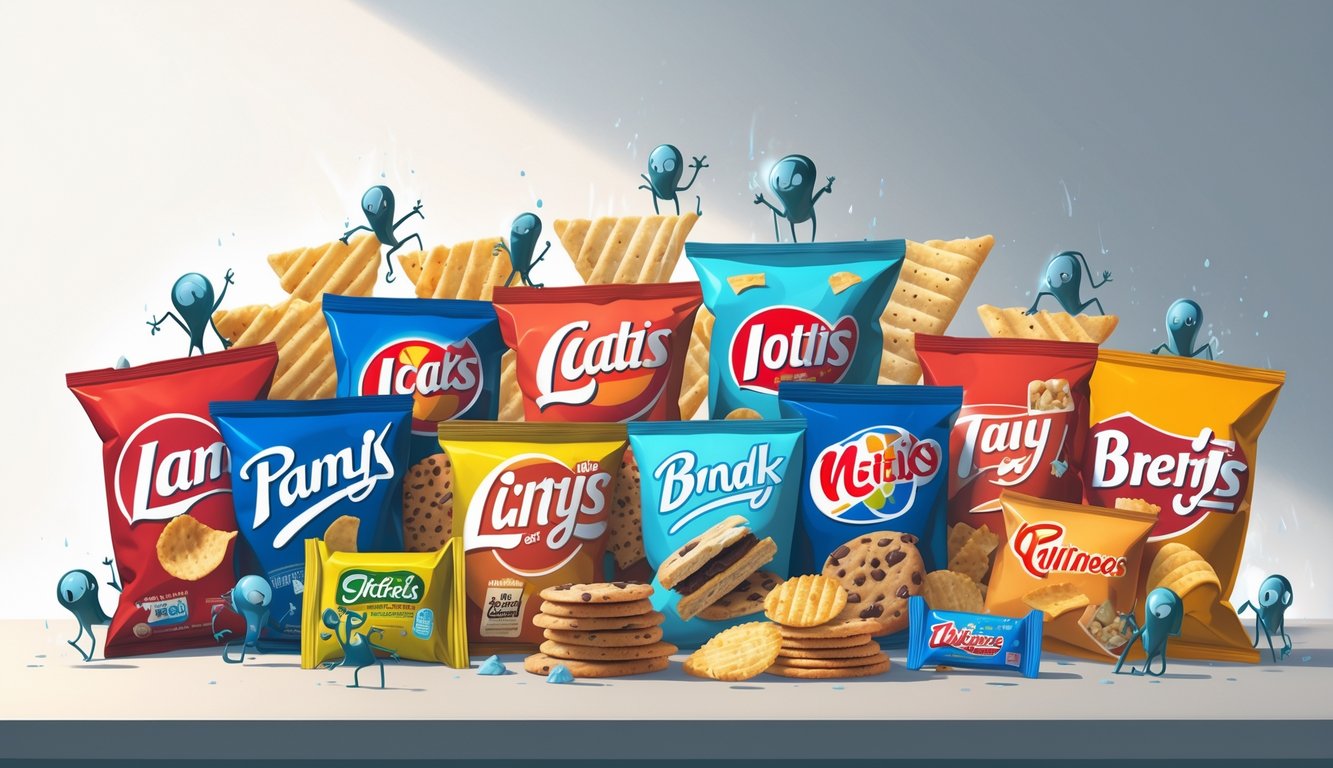
The Most Common Harmful Additives in Snack Foods
I dig through another bag of chips, and the label just mocks me. Chemical names everywhere, even on snacks that brag about being “natural.” Never just potatoes, never just salt.
Trans Fats and Partially Hydrogenated Oils
Why does my favorite popcorn still list “partially hydrogenated oils” right after corn? FDA says trans fats aren’t safe, but brands still sneak them in for texture and shelf life. Pretzels, too—flip the bag over and you might spot them, even after the supposed ban. They just use the “0 grams per serving” trick. Infuriating.
Doctors at Mayo Clinic are blunt: any amount of trans fats is bad for your heart. They show up in more than just junk food—pizza dough, margarine, microwave popcorn. “Partially hydrogenated” isn’t a loophole you want to fall into, but you’ll need eagle eyes to catch it. Nobody brags about that.
Artificial Sweeteners and High-Fructose Corn Syrup
I don’t know a single person who wants yogurt to taste sweeter, but here we are—aisles full of aspartame, sucralose, saccharin, and high-fructose corn syrup (HFCS). HFCS tries to sound innocent—“it’s from corn!”—but Yale research links it to blood sugar spikes and fatty liver. Great.
Aspartame? FDA says it’s fine, but some people (PKU) can’t touch it, and there are studies about headaches and who knows what else. Acesulfame potassium sneaks into “low sugar” granola bars, just buried under branding. Not saying sweeteners are evil, but who decided vanilla rice cakes need both sucralose and HFCS? Nobody’s asking for snacks to be this complicated.
Synthetic Dyes and Artificial Colors
Fruit-flavored snacks—shouldn’t they, I don’t know, use actual fruit for color? But no, it’s just Red 40, Yellow 5, and a whole mess of synthetic dyes dumped into everything from neon sports drinks to crackers that are somehow both orange and dry. FDA says these dyes are “safe.” Whatever that means; meanwhile, UK researchers keep muttering about azo dyes and hyperactivity in kids. I tried scrubbing this weird orange blotch from my shirt once—totally artificial dye, not carrot. Disaster.
Cereal mixes and those sour gummy worms? They love Red 40 and Yellow 6—so bright it’s almost aggressive. Why can’t they use beet juice or turmeric? Oh right, “cost.” European snacks sometimes ban these colors or slap on warning labels, but in the U.S., it’s like we crave the glow-in-the-dark breakfast look. Maybe we do. Hard to say.
Emulsifiers, Thickeners, and Stabilizers
Ever tried stirring natural peanut butter? I have. Total fail. So, food techs toss in soy lecithin, mono- and diglycerides, and, get this, carboxymethylcellulose (try saying that three times fast). These make oil and water play nice, which sounds cool until you stumble on studies (American Journal of Clinical Nutrition, 2021) hinting at weird gut bacteria changes. Not exactly confidence-inspiring.
BHA and BHT—those aren’t for taste, just to keep chips from going stale. Like, microscopic mall cops for snacks. WHO calls them possible carcinogens, but they’re still hanging out in boxed cookies, right between cornstarch and palm oil. Modified food starch? Just a thickener. Adds nothing but texture, at least according to every nutritionist I’ve ever met. If you like your pudding slippery and your soup immortal, congrats, you’re eating modern chemistry.
Spotlight on Controversial Additives
Still have no clue how cheddar puffs stay so orange or why they last longer than my last relationship. Additives, obviously. I’ve tried to keep up with ingredient lists—impossible. Snack companies bury these compounds under “flavor-boost” or “freshness” nonsense, and somehow they dodge bans and keep popping up on breakfast tables.
Sodium Nitrite, Nitrates, and Nitrosamines
Jerky bags, suspiciously pink deli meats, that weird tang—yep, sodium nitrite, supposedly to “prevent botulism,” which sounds dramatic. FDA lets companies use it for curing, color, “safety.” Big deli brands worship the 200 ppm limit, but European Food Safety Authority called even tiny doses “problematic” last year.
Then there’s nitrosamines. These can form when nitrite hits protein and heat. WHO says some nitrosamines are probably carcinogenic. That’s…not ideal. Sodium benzoate? It shows up in drinks with ascorbic acid, and that combo can make benzene. FDA seems chill about tiny amounts. Meanwhile, I’m suspiciously eyeing every sports drink.
And what about Grandma’s salty ham? Sat in the fridge for weeks, nobody died. Maybe the problem isn’t preservatives, it’s us eating five servings instead of one. And “uncured” meats? Usually just a loophole—celery powder has natural nitrates, does the same thing.
Potassium Bromate and Brominated Vegetable Oil
Potassium bromate—never seen it in my kitchen, but it’s in commercial breads and buns, lurking like an awkward guest. Alt-weeklies love to scream “carcinogenic in rats!” but FDA shrugs and says it’s fine “if used properly.” Europe and Canada ditched it ages ago. Found it once in a supermarket hot dog bun, sandwiched between wheat flour and “dough conditioners.” Tempting.
Brominated Vegetable Oil (BVO)? That’s a saga. Mountain Dew, citrus sodas, it was everywhere till backlash forced some reformulations. Mayo Clinic folks warn it messes with thyroid hormones, builds up in fat tissue—kind of freaked me out, honestly, but I pretended not to care. FDA still lets it slide in tiny doses.
People who brag about “zero bromate” bread have clearly never tried to keep kids happy with supermarket loaves. Maybe swap ingredients, not just brands. Still waiting for someone to explain why “dangerous” in one country is “fine” in another. Anyone?
Propylene Glycol and Carrageenan
Standing in the dairy aisle, staring at yogurt that’ll outlive me—propylene glycol, aka “food-grade antifreeze,” sneaks into cake mixes, icings, salad dressings. FDA and WHO call it “generally recognized as safe” up to 25 mg/kg body weight. Inspiring, except Canada banned it from cat food but lets humans eat it. Sure, that tracks.
Carrageenan, the “natural” thickener from seaweed, makes almond milk and soups creamy. Dr. Joanne Slavin (University of Minnesota) used to brush it off, then animal studies popped up, and now everyone’s whispering about “inflammation” and “gut health” at yoga class. FDA hasn’t banned it, but some brands swap it for guar gum—supposedly “cleaner,” but honestly, nobody mentions if the taste gets worse.
A friend swore her oatmeal lattes were “additive-free,” but her non-dairy creamer had both propylene glycol and carrageenan. So, yeah, reading ingredient lists matters—sometimes. But why does “stabilizer” sound so much sketchier outside a chemistry textbook?
Health Risks Linked to Snack Additives
Last time I dug through a crinkly snack bag, I caught myself squinting at ingredients I’d never even consider buying. Snack makers throw in additives for shelf life or fake flavors and colors, not for nutrition. Risks? Not just theoretical—actual research spells it out.
Cancer and Carcinogenic Effects
What still bugs me: why is Red 40, banned in some places, totally fine here? FDA signed off on some dyes after industry-funded tests—sketchy. You won’t see an oncologist munching on neon snacks. Multiple studies link nitrites, synthetic colors, and preservatives to carcinogenic effects.
Companies actually add stuff to snack cakes that researchers—like Dr. Mathilde Touvier—connect to cancer. French cohort analysis? More additives, more cancer risk. They always say “just trace amounts,” but if you eat snacks like I used to, those traces add up fast.
And honestly, how does “possibly carcinogenic” get a pass just because it’s under some arbitrary limit? Am I the only one thinking about cumulative exposure? Probably not.



